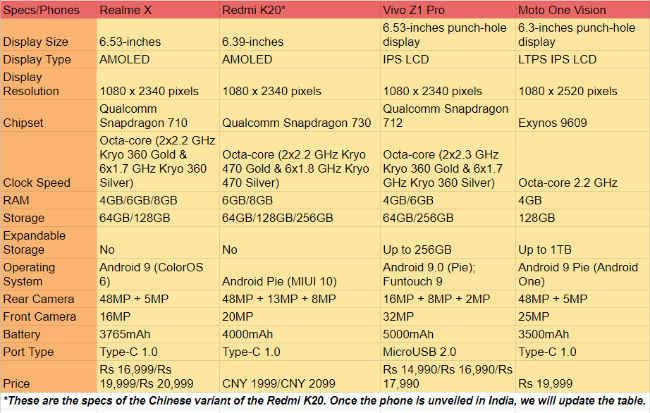In a span of about a month, three different OEMs Realme, Vivo and Motorola have launched their mid-range devices in India. The fourth one, Redmi, will launch its device in this segment tomorrow. While Relame X and Moto One Vision devices were launched in different markets before they made landfall in India, the Vivo Z1 Pro was first introduced in the country. Redmi K20 and its elder sibling, the Redmi K20 Pro, have already been launched in China. Here, we have compared the specs of three phones that are already available in the country, and included the specs of the Chinese variant of the Redmi K20. Let's take a look at how these devices fare against each other, on paper.

Display and Design
The Realme X features a 6.53-inch Super AMOLED display with a 19.5:9 aspect ratio. The display offers and 1080 x 2340 pixels resolution, and the pop-up selfie camera mechanism is claimed to give the phone a 91.2-percent screen-to-body ratio. In comparison, the Redmi K20 features a Full HD+ 6.39-inch Super AMOLED display that offers the same resolution. The display stretches edge-to-edge offering 91.6 percent screen-to-body-ratio, and 19.5:9 aspect ratio. It has the same pop-up mechanism as the Realme X.
The Vivo Z1 Pro features a 6.53-inch full HD+ with same resolution as the above mentioned phones. It sports an IPS display, which houses a punch-hole selfie camera. The Motorola One Vision sports a 6.3-inch LTPS IPS LCD panel that offers a resolution of 1080 x 2520 pixels. It delivers an 82.5 percent screen-to-body ratio, and one of the USPs of the phone is it tall 21:9 ratio CinemaVision screen.
Performance
The Realme X features the Qualcomm Snapdragon 710 chipset. In comparison, the Redmi K20 has the Qualcomm Snapdragon 730 processor under the hood, and ships with Game Turbo 2.0 touted to deliver an enhanced gaming experience. The Vivo Z1 Pro is shipped with the Qualcomm Snapdragon 712 SoC, and just like the Redmi K20, it also features gaming enhancement options such as Game Cube and eSports mode. Motorola has chosen to go with a Samsung Exynos 9609 processor in the Moto One Vision.
Memory and storage
The Realme X is offered in two variants: 4GB RAM + 128GB storage and 8GB RAM and 128GB storage. Realme has also launched the Master Edition of its flagship phone - onion and garlic gradients - with 8GB RAM and 128GB storage. There is a Spiderman special edition as well that also sports 8GB RAM and 128GB of internal storage. The Redmi K20 is offered in 6GB RAM + 64GB storage, and the 6GB RAM + 128GB storage variants. The Vivo Z1 Pro comes in three variants: 4GB RAM + 64GB storage, 6GB + 64GB storage 6GB RAM + 128GB storage variant. The Motorola One Vision is offered in just one 4GB RAM and 128GB storage variant.
Camera
On the optics front, the Realme X features a dual rear camera setup that includes a primary 48MP Sony IMX586 sensor and a secondary 5MP depth sensor. It offers features like Nightscape and Chroma Boost. Additionally, the 16MP front camera resides in the pop-up mechanism. Realme says that the pop-up camera rises in just 0.74 seconds and has a fall-detection feature.
When it comes to the Redmi K20, there is a vertically stacked triple camera setup on the back panel. The primary shooter is the 48MP sensor, but instead of the Sony IMX586, it has the Sony IMX582 sensor with an aperture of f/1.75. There is a 13MP secondary sensor with a wide-angle lens and the telephoto lens comes along with an 8MP sensor with an aperture of f/2.4. The phone’s camera will be able to record slow-motion video at up to 960fps videos. The selfie camera has a 20MP sensor.
The Vivo Z1 Pro also comes with triple-rear cameras but it sports a 16MP primary sensor with an f/1.78 lens, an 8MP secondary sensor with a 120-degree super wide-angle f/2.2 lens, and a 2MP depth sensor with an f/2.4 aperture lens. However, it has a 32MP sensor in the selfie shooter, which is more resolution than all the phones compared here.
Like Realme X, the Moto One Vision also has two cameras on the back. The primary unit is a 48MP Samsung-made sensor and an f/1.7 aperture. It is a 1/2.25-inch quad-pixel sensor that combines four pixels into one large pixel to deliver better images. The secondary camera has a 5MP sensor for depth sensing. On the front is a 25MP unit with the same quad-pixel technology as the primary rear camera.
Battery and other features
The Realme X packs a 3745mAh battery, which supports 20W VOOC-charge technology. Also, it features an in-display fingerprint scanner. It runs Android 9 Pie with ColorOS 6 on top. The Realme X also supports Dolby Atmos for an immersive sound experience via headphones. The Redmi K20 draws its power from a 4,000mAh battery that comes with an 18W fast charge. The phone also sports an in-display fingerprint sensor.
Vivo is focusing on the budget gaming segment with the Z1 Pro, hence, it has put a 5000mAh battery with an 18W fast charger. The phone runs on Funtouch OS 9, which is based on Android 9 Pie. As mentioned in the table, the phone is an Android One device, which means that it will get timely security updates and at least two major OS versions. The phone runs the Android 9 Pie OS and has Moto Actions that we have already seen in other offerings from Motorola. The phone has a 3500mAh battery with 15W fast charging support. The fingerprint sensor is incorporated Motorola’s famous batwing logo.

from Latest Technology News https://ift.tt/2kgb54e


